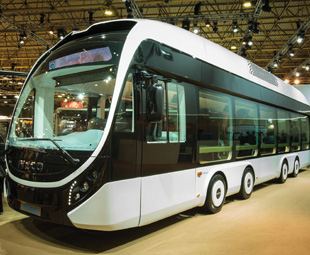The future of bus design starts here!

FRANK BEETON reports on a most unusual concept bus from Iveco.
In recent articles dealing with alternative driveline technologies, we have alluded to some new layout possibilities opened up by the development of hybrid and all-electric vehicles through the fresh thinking applied to the design of the components they are able to use.
Notably, this has included the replacement of conventional drive axles by individual in-wheel electric motors. This is particularly appropriate when discussing low-floor city buses, where attempts to create really low loading heights have been frustrated by the necessity to accommodate a live drive axle as well as the traditional propeller shaft.
Partial relief has been obtained by adopting independent front suspensions and portal drive axles where the solid axle, containing the drive shafts, has been offset to a position below the wheel centres.
However, any alternative that eliminates any need for a mechanical drivetrain is the Holy Grail for really low-floor designs – and in-wheel electric motors provide just that possibility.
At the Busworld Show, held in Kortrijk, Belgium, during October 2013, Iveco displayed its ELLISUP concept bus. At first glance, this vehicle was unusual in having eight small diameter road wheels, a roof-mounted pantograph and an exceptionally large window area.
As the name suggests, this design has been developed to fulfil the mandate of the French Environment and Energy Management Agency’s ELLISUP programme project – which is to develop a new electric bus concept that is able to operate in full electric mode along an entire service line and rapidly recharge its batteries at the end of the line, with ownership costs between those of a typical diesel bus and trolleybus.
The participants, in addition to project leader Iveco, include Michelin, a whole host of French agencies and state-owned entities and RECUPYL, a company specialising in the innovative recycling of batteries into strategic metals.
Apart from a most unusual appearance, the design incorporates numerous innovations which may be useful pointers to future bus design trends. Of the eight small 17,5-inch diameter wheels, the four rearmost are driven by Michelin-developed electric motors, which draw their power from a combination of lithium batteries and supercapacitors. These are replenished by a combination of regenerative braking and a pantograph system that connects with charging stations at route termini. Steering of this 20-tonne (gross) vehicle is executed by the foremost pair of wheels, as well as the four rear drive wheels.
The bus has exceptionally large, deep panoramic windows and is claimed to offer a 20 percent increase in passenger capacity compared to a normal full-sized bus. This is presumably because of reduced intrusion into interior space by undercarriage and driveline components. Innovative features include two driver-assistance systems with stereoscopic cameras and proximity/blind spot warnings, built-in door sensors to avoid passenger entrapment, seat sensors that control lighting for each individual passenger, LED interior lighting with frequent theme colour changes, a wireless passenger communication system, acoustic ceiling and four eye-level LCD screens providing route information and local shopping updates.
The ELLISUP concept bus is currently operating on a four-kilometre, proof-of-concept test route in Grenoble. However, its real value is in illustrating the potential of “clean-sheet” design when internal combustion engines, gearboxes and drivelines are taken out of the equation.
It is very refreshing to see the level of innovative thinking that has gone into this design. In our view, public passenger transport is an ideal proving ground for driveline innovation, as it keeps to regular routes and timetables, and its vehicles are readily accessible for planned and unplanned maintenance.
It seems counterproductive to stay with conventional solutions in an environment such as bus rapid transit, where every facility is available to try something new, with minimum risk.
Published by
Focus on Transport
focusmagsa




 !
From 1 Apri
!
From 1 Apri

 Big news from FOCUS on Transport + Logist
Big news from FOCUS on Transport + Logist





 FUSO: Driving the Future of Mobile Healthc
FUSO: Driving the Future of Mobile Healthc



 A brand
A brand




 Wondering about the maximum legal load for a
Wondering about the maximum legal load for a 
 The MAN hTGX powered by a hydrogen combus
The MAN hTGX powered by a hydrogen combus

 Exciting News for South African Operators
Exciting News for South African Operators
